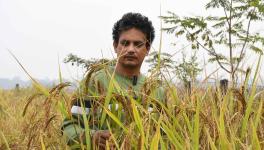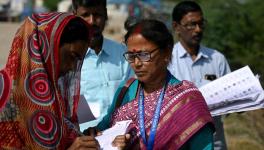COVID-19: The Second Wave Is Not Over Yet
Representational use only.
Such is the desperation to hear some good news, among both, the people and the government, that what stares you in the face is often ignored. This happened after the first wave of COVID-19 subsided at the end of last year and beginning of this year. And, faced with the catastrophic second wave, the same thing is happening. The second wave has been almost declared finished. There is urgent anticipation of reopening of this and that. There is more caution but it is fast evaporating.
Reality is far grimmer than these childish wishes. On June 1, India recorded 1.33 lakh new cases. This is down from the chilling peak of 4.12 lakh reached almost a month ago, on May 6. [See chart below] So there is sufficient cause to say that the second wave is receding. But have a second look – at what the peak of the first wave was. On September 16, 2020, daily new cases peaked at 96,424. So, new cases on June 1 are roughly 38% higher than what was the peak last year. Data is drawn from the Health Ministry.
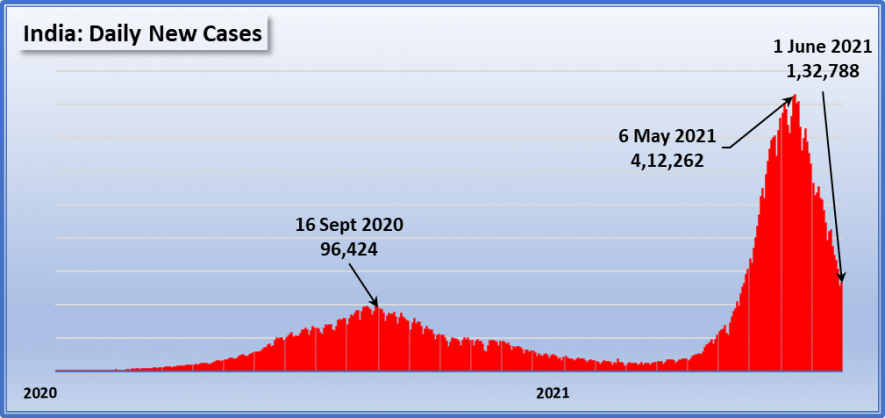
Loss of lives due to COVID-19 is following the same pattern, naturally. Thus, peak of daily deaths in the first wave was 1,290, reached on September 15, 2020. Presently, it is far more. On June 1, India reported 3,207 deaths – that’s over one and a half times more than the first wave peak.
In short, things are better than early May of this year, but they are far worse than the worst of last year. Many more people are suffering, many more are dying – and the country is also carrying the unconscionable burden of 2.8 crore (28 million) COVID-19 cases all told and a chilling 3.35 lakh deaths. It would be immoral and inhuman to celebrate the passing away of the second wave.
Changes in Spread
But this is not just an academic issue. Can one learn anything from the ferocity and spread of the second wave even as it continues to rage? Yes, and for that one has to look at the nature of this second wave.
It is different from the first one in its spread. The deadly virus has evidently spread to rural areas. Several analyses have shown this, as have harrowing tales of how people in far flung villages, bereft of modern healthcare system’s abilities, have been afflicted by the disease, gone through it untested and undiagnosed – and either survived or succumbed. Official records may not have a measure of this but the truth cannot be denied. Even deficient official statistics show that predominantly rural districts that were less affected in the first wave are reeling under the disease.
The other aspect is that the second wave is also ripping through whole states even now when new cases have started declining in other usually more affected states. Let us take the example of the eight North Eastern states.
North-Eastern States
Assam, the biggest state in the region in terms of population, followed the same pattern as many other big states. It recorded 3,480 new cases on April 15, 2021. New cases relentlessly increased after that to reach a peak of 8,075 on April 28. This day could be an outlier as it shows a single day anomalous spike. Perhaps the real peak was on May 6 when new cases touched 6,974. After that there was a steady decline to 831 cases on May 31. The second wave had subsided.
But the other seven North-Eastern states (Sikkim, Arunachal Pradesh, Nagaland, Mizoram, Manipur and Tripura) show a different trajectory, as shown in the chart below. Total cases in these seven states have risen from just 235 on April 15 to 3,015 on May 31. It is not a straight line but the trend is clearly increasing, with some hesitant sign of slowing down in the last few days.
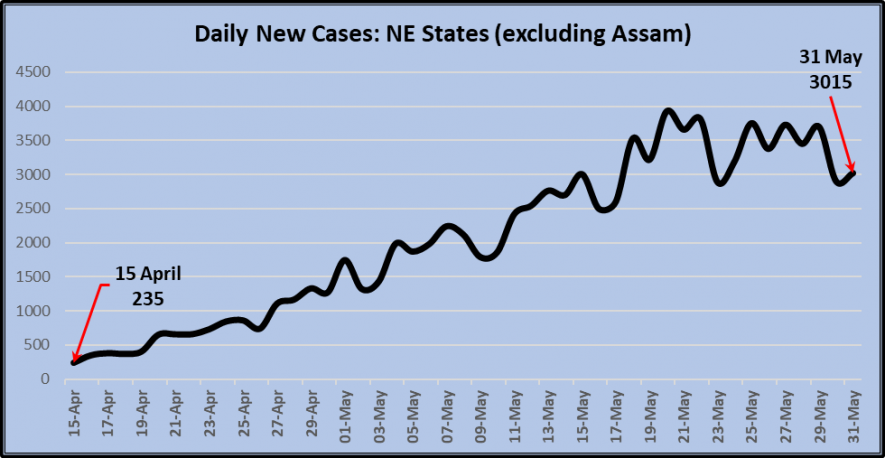
The second wave is still on in these small states. With their fragile healthcare system, remote communities and strife threats, the spread of COVID-19 in these parts of India is an ominous portent. Populations are small and scattered, so the numbers are not as striking as the bigger states, but the calamity is felt as badly as anywhere else. And, it may leave wounds that last longer.
West Bengal, Odisha, Tamil Nadu and Telangana
In four other states, two in the east and two in the south, the second wave is similarly still in progress, showing signs of slowing but not significant decline. These states are West Bengal and Odisha in the east and Telangana and Tamil Nadu in the South. [See chart below]
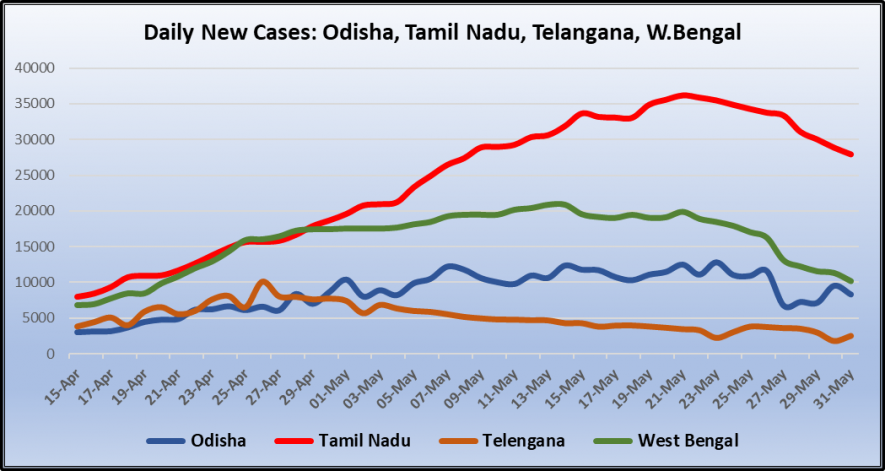
Unlike the considerable decline in new cases seen in most of the other affected states, daily new cases as recorded rose since April 15, especially in Tamil Nadu and West Bengal, and have only slightly dipped in the last week of May. In Odisha, new cases recorded on April 15 were 2,898, rising to 12,852 on May 23, an increase of nearly four and a half times. Thereafter they have dipped to 8,313 on May 31. This is still two and a half times more than April 15.
In West Bengal, new cases rose from 6,769 on April 15 to a peak of 20,846 on May 14 and have since declined slowly to 10,137 on May 31. That is still over 30% higher than the beginning of the second wave. In Tamil Nadu, too, new cases increased from 7,987 on April 15 to 36,184 on May 21 and then dipped to 27,936 on May 31, a dip of about 30% from the peak but still over three times more than the what they were on April 15.
What all this shows is that in many big and small states, the virus is steadily penetrating vast untouched swathes, finding an ever-present pool of as yet untouched people. This is not only increasing the numbers of those affected but as epidemiologists have repeatedly pointed out, providing a fertile ground for more mutated versions to evolve and for the pandemic to be kept alive, far away from media spotlight. Then, after a tipping point is reached it will surge back into lime light, to be called the third wave.
[Data collated by Pulkit Sharma]
Get the latest reports & analysis with people's perspective on Protests, movements & deep analytical videos, discussions of the current affairs in your Telegram app. Subscribe to NewsClick's Telegram channel & get Real-Time updates on stories, as they get published on our website.











